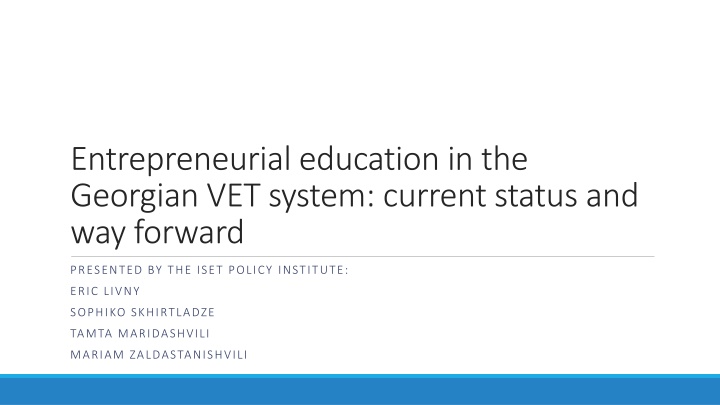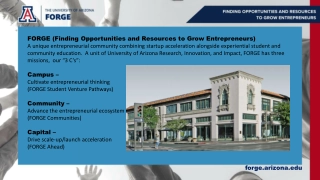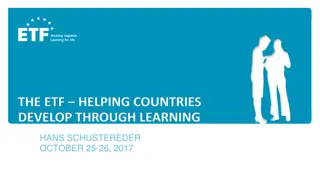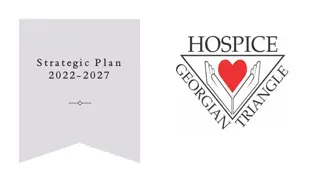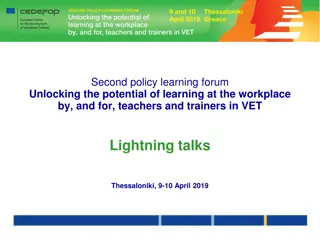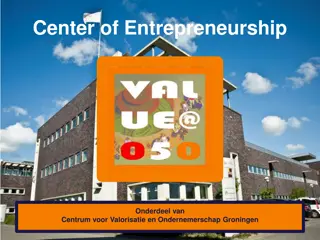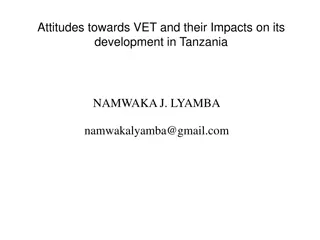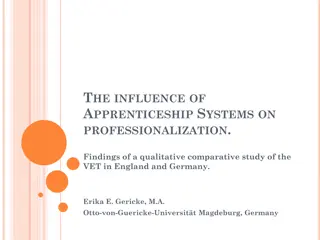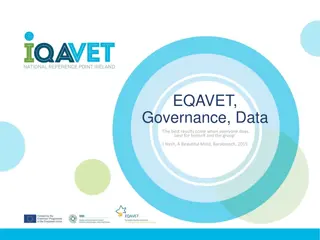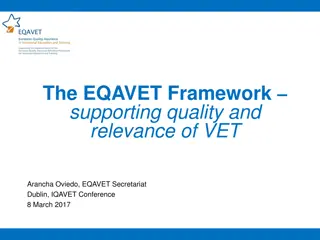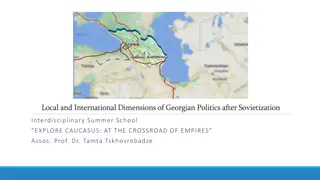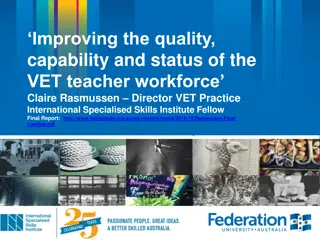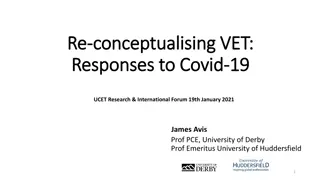Entrepreneurial Education in the Georgian VET System: Current Status and Way Forward
Delve into the current status and future prospects of entrepreneurial education in the Georgian VET system as presented by the ISET Policy Institute. Explore insights from Eric Livny, Sophiko Skhirtladze, Tamta Maridashvili, and Mariam Zaldastanishvili.
Download Presentation

Please find below an Image/Link to download the presentation.
The content on the website is provided AS IS for your information and personal use only. It may not be sold, licensed, or shared on other websites without obtaining consent from the author.If you encounter any issues during the download, it is possible that the publisher has removed the file from their server.
You are allowed to download the files provided on this website for personal or commercial use, subject to the condition that they are used lawfully. All files are the property of their respective owners.
The content on the website is provided AS IS for your information and personal use only. It may not be sold, licensed, or shared on other websites without obtaining consent from the author.
E N D
Presentation Transcript
Entrepreneurial education in the Georgian VET system: current status and way forward PRESENTED BY THE ISET POLICY INSTITUTE: ERIC LIVNY SOPHIKO SKHIRTLADZE TAMTA MARIDASHVILI MARIAM ZALDASTANISHVILI
Introduction Introduction Aim of the project: Strengthen entrepreneurship education in Georgian VET institutions: 1) Improve existing modular entrepreneurial training; 2) Identify talented students; 3) Incubate young talented entrepreneurs. Steps taken: Desk research about European best practices; Visits to 12 Georgian VET institutions (both public and private); Interviews with VET experts (Anthony Tyrrel, Kakhaber Eradze) and alumni (owners of small businesses).
Why entrepreneurial training? Why entrepreneurial training? By improving entrepreneurial education and follow up support systems we can achieve the following: Increase self-employability of the VET graduates; Increase the attractiveness of VET as an alternative to higher education; Develop the culture of entrepreneurship in Georgia.
Post Post- -secondary vocational training is not an attractive secondary vocational training is not an attractive option for Georgian youth option for Georgian youth GROSS ENROLMENT RATIO, POST- SECONDARY NON-TERTIARY IN 2013 (%) THE NUMBERS OF ENTRANTS IN VET AND HIGHER EDUCATION COMPARED (2014) Czech Republic 47.18 18 18- -year year old age cohort old age cohort 52 000 52 000- -55 000 55 000 Estonia 32.82 Higher Higher education entrants education entrants 26 377 26 377 Germany 31.5 Azerbaijan VET entrants: VET entrants: 24.08 Switzerland 13.87 Cohort 15 Cohort 15- -19 19 2 418 2 418 Austria 6.67 Cohort 20 Cohort 20- -24 24 3 102 3 102 Latvia 6.59 Cohort 25 Cohort 25- -29 29 1 226 1 226 Georgia 0.57 Other cohorts in sum Other cohorts in sum 1 676 1 676 0 10 20 30 40 50 Source: UNESCO Institute for Statistics Source: UNESCO Institute for Statistics Source: Source: National Statistics Office of Georgia and EUVEGE National Statistics Office of Georgia and EUVEGE
Entrepreneurial training is relevant for a very small Entrepreneurial training is relevant for a very small share of VET college population share of VET college population Number of VET institutions: 105 Private; 35 Public Share of students by study fields Occupation of VET graduates (2014) Agricultural Sciences 10% Health 15% 50 45 46% 40 Art 8% 40% 35 Business Administration 22% 30 Law 5% 25 20 Interdisciplinary 8% 15 17% Engineering 32% 10 5 5% 0 Unemployed Employed Self-employed Other Source: Source: National Statistics Office of Georgia National Statistics Office of Georgia
Entrepreneurship training in Georgias VET system Entrepreneurship training in Georgia s VET system Entrepreneurial training is not the bread and butter of Georgian VET institutions: Georgian VET institutions mainly concentrate on preparing students for employment, not breeding entrepreneurs (this is especially true for the private VET institutions); The new entrepreneurship module continuesa previous course in economics (or business administration). The main difference is in form (longer teaching hours and a different name), not substance; Most entrepreneurship teachers have not changed. They are experienced economics or business administration teachers who have participated in a three-day workshop delivered by the National Center for Educational Quality Enhancement (rather than retrained ).
What is What is being taught being taught: : The majority of VET institutions have already integrated entrepreneurship module as a mandatory component of their educational programs; Level three and four modules have very similar learning outcomes: Level three module outcomes: Business planning Registration of business Organization of business Sales of goods and services Simplified bookkeeping Level four module outcomes: Level three module outcomes + Organization of human resources The main practical requirement of both modules and the only evaluation instrument is an individual business plan; Reported weaknesses: the course is too demanding for (barely literate) level 3 students.
What materials are used What materials are used? ? The most frequently used literature the book Entrepreneurship by LEPL National Center for Educational Quality Enhancement; The book includes: Exercises in e.g. basic accounting and questions summarizing each chapter like group these companies according to their type of activity ; Very few real life examples, such as the story of Bill Gates, that that are of limited utility for aspiring young Georgian entrepreneurs. Recommendation: Include many more Georgian Case studies with a focus on small businesses started by young entrepreneurs (e.g. the story of winemaker Baia; enamel business started by VET alumna Lali Shpetishvili), challenges they faced and dealt with.
Entrepreneurship teachers Entrepreneurship teachers Mostly women in the 40-60 age bracket; The majority hold economics/business administration degrees received in the Soviet or early post- Soviet period; Lack industry or business-related experience. Recommendations: Attract new, younger teachers with business-related experience (use the SSE-Riga alumni mentor club model as a source of inspiration); Engage successful alumni with entrepreneurial experience to hold master classes; Arrange business internships for teachers (French best practice); Engage other teachers (farming, hairdressing, winemaking professionals) in the delivery of entrepreneurship training and development of business plans. Consider translating and adapting for the Georgian context online training modules available from e.g. the Harvard Business Publishing and the Shaw Academy (Ireland)
How is the module taught? How is the module taught? Mostly top-down lecturing, lack of classroom interaction; Lack of opportunities to practice what students learn: practice is limited to doing text-book exercises rather than field work; Very little team work and group assignments; Students projects evaluated on a pass/fail basis, no way to differentiate students achievement; Internships limited to occupational trainings in large businesses. Recommendations: Introduce greater student interaction (student presentations, brainstorming, Q&A) to achieve learning outcomes such as: students provide justification for own business idea or adequately describe the risks associated with the implementation of the business idea (under business planning ); Include assignments requiring field work, market research, group tasks and projects; Include visits and internships at start-up companies.
Complementary and follow up activities Complementary and follow up activities A very small number of colleges run mini-companies (e.g. a small hotel inside the Akhali Talga college) because they operate under the whatever is not allowed is forbidden paradigm. Such companies have many pedagogical advantages for entrepreneurship training; Fab Labs are underutilizedfor lack of adequate skills. There are exceptions such as at Gldani Vocational Training Center , where a Fab Lab is utilized for student competitions (the director is an enthusiast); No systematic external and internal communication about national business competitions, e.g. Produce in Georgia . In a few success stories, the college played no role in informing and supporting applicants (the case of Khatuna Khabelashvili, from public college Gantiadi ). Recommendations: Make systematic use of available pedagogical infrastructure (e.g. Fab Labs), other internal and external resources (national business competitions) to develop entrepreneurial skills and promote young entrepreneurs. In particular, at least one person at each college has to be properly trained in the use of sophisticated infrastructure, such as Fab Labs. Such people should be trained outside the college system e.g. in coordination with the Georgian Innovation and Technology Agency)
The role of The role of the private the private sector sector: : Master classes focused on professional skills (say, welding), not entrepreneurship; Some regular teaching is done by professionals on an individual basis with no institutional relationship; Companies host interns for professional skills enhancement with an eye to hiring some of them; there is no emphasis on using internships to develop entrepreneurial skills. Recommendations: Need much more systematic engagement with the private sector in: 1) Governance of VET institutions; 1) Teaching entrepreneurial subjects, delivering master classes, and hosting visits by student groups; 2) Discussion and elaboration of business plans (use Swiss experience); 3) Hosting of interns (in start-up enterprises rather than in big companies); 4) Selection of business ideas/plans; 5) Incubation of the best business ideas/teams.
Our Big Ideas for Improvement Hold best pedagogical practice competitions to encourage innovation and experimentation in the teaching and practicing of entrepreneurship; Engage students in running mini companies; Organize multi-stage competitions, in partnership with the private sector, to identify and nurture talented entrepreneurs;
Best pedagogical practice competitions to encourage greater Best pedagogical practice competitions to encourage greater experimentation, horizontal learning and networking experimentation, horizontal learning and networking VET institutions tend to follow established standards. What is needed, however, is not only greater freedom ( what is not forbidden is allowed ) to try new approaches but also active encouragement and support of innovation. For example this could be achieved through competitions among VET institutions to incentivize the generation of new ideas and provide winners with funding and/or equipment to implement them; Horizontal learning could be supported through an open selection process involving presentations of innovative ideas and experience sharing by college teams; Selection panel could include Georgian business associations, industry and MES representatives (for vertical coordination). There is a need to mobilize financial resources for such activities; the Ministry of Education organized a best-practice workshop for directors of VET institutions in summer 2015, which is said to have greatly facilitated horizontal learning. The workshop was discontinued for a lack of funding. According to MES staff, ideally, not only directors should be involved in such workshops. The inter-college competitions should also allow to create a ranking of VET institutions (based on the success in these competitions but also on the success of their students), which would help inform student choice and motivate colleges to innovate and further improve their performance.
Engaging students in running mini Engaging students in running mini- -companies If needed, modify existing legislation to explicitly allow VET institutions to perform auxiliary entrepreneurial activities (as is the case of higher education institutions under the Law on Legal Entities of Public Law (LEPL); Encourage VET institutions to establish mini-companies to be operated (on a non- profit basis) by students with mentoring by private business partners and faculty. (Use the Maltese and German models for reference); Such mini-companies could be used to achieve many entrepreneurship-related learning outcomes. For example, while operating such a company in the real world students can learn: 1) To work in a team, delegate responsibilities, set targets, monitor performance, instill motivation, plan business activities (all these are learning outcomes under organization of business , and organization of human resources ); 2) To analyze competition and demand, set prices, brand and differentiate their products, adjust product and service quality, design effective marketing campaigns, etc.). companies
The law on LEPL 2a. A legal entity under public law a higher educational institution shall be authorized to: a) perform educational, and scientific and research activities; b) perform publishing activities; c) sell the output produced in the course of educational, scientific and research activities; d) produce and sell the output (inventions and useful models) produced in the course of scientific research and laboratory activities; e) perform auxiliary entrepreneurial activities if so provided by its statute (regulations);
Selection and incubation Selection and incubation of talented entrepreneurs (based on the of talented entrepreneurs (based on the Hungarian Hungarian model) model) First stage: Aptitude tests to identify individuals with entrepreneurial traits, knowledge and skills College level, with the help of private sector partners (based on Swiss model) Second stage: Business idea/plan competition Third stage: National business idea/plan competition, jointly administered by an association of VET colleges, GCCI and other business associations National level, coordinated by an association of VET institutions, GCCI and other business associations Fourth stage: Entrepreneurship Academy established by the GCCI and other business association to provide mentorship support and a framework for small business incubation
